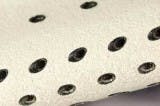Rotherham, UK -- A new state-of-the-art turbine blade facility being built by Rolls-Royce raises expectations of new business for suppliers of laser-drilling systems.
Laser processing of turbine blades was one of the earliest industrial laser applications to take advantage of the laser beam's ability to rapidly drill small cooling holes on curved airfoil surfaces. Then in direct competition with EDM operations, the laser became the technology of choice as the holes/blade increased and the complexity of the airfoil changed. Then, with the need to produce more cooling for new engine blades, the use of the laser to drill large rectangular hole patterns solidified the industrial laser as the process of choice.
Rolls-Royce's planned new 14,000 m2 facility will be one of the most advanced blade casting facilities in the world, featuring groundbreaking manufacturing techniques such as 3D structured light for geometry inspection, according to the company. Initial production of single-crystal turbine blades for large civil aero engines is expected to start in 2014, ramping to eventual full capacity of 100,000 blades/year.
"Rolls-Royce invests in world-class technology and infrastructure to expand the scale and efficiency of our operations and to deliver our promises to our customers," noted Mike Mosley, EVP of the company's turbines business. He added that the company has invested over £950 million (€1.18 billion) over the past five years just on its UK infrastructure.
Single-crystal turbine blades are a critical component of jet engines; over 65 are used in every Trent engine. Each one extracts around 1000 horsepower (equivalent to an F1 racing car) from the gas flow toward the rear of the engine to drive the engine's compressors. They operate in temperatures up to 200°C above the melting point of their alloy, and sit in a disc rotating at >12,000 rpm -- a centrifugal force equivalent to the weight of a London bus.
Sponsored Recommendations
Sponsored Recommendations
Request a free Micro 3D Printed sample part
April 11, 2024
How to Tune Servo Systems: The Basics
April 10, 2024
Voice your opinion!
Voice your opinion!
